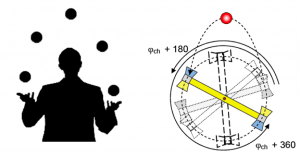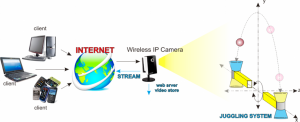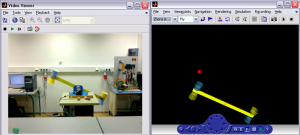Monitoring of juggler system using wireless ip camera
26. Október, 2011, Autor článku: Triaška Stanislav, Elektrotechnika
Ročník 4, číslo 10  Pridať príspevok
Pridať príspevok
![]() In this article we will provide our option on external monitoring of juggler system. For system monitoring we used wireless IP camera. By this camera we can compare video file of real juggler system and virtual juggler model based on mathematical model. Program for comparing and virtual model of juggler system are developed in Matlab/Simulink program.
In this article we will provide our option on external monitoring of juggler system. For system monitoring we used wireless IP camera. By this camera we can compare video file of real juggler system and virtual juggler model based on mathematical model. Program for comparing and virtual model of juggler system are developed in Matlab/Simulink program.
1. Introduction
Nowadays the servo drive systems are mostly used in robotics manipulation, industrial application, automations etc. All of these applications have exactly specified tasks what to do, and how to do. Juggling with the servo drive is very interesting and very difficult indeed. Applications like juggling with servo drive require repeatable movements of high speed and precise control. Considering the controlling system and DoF, the jugglers and the juggling algorithm are different.
In the article “Control of the Ball Juggler” [4] is shown one of possible methods to identification system parameters and way how to design juggler controller for our system. In the papers “Control of the Juggling System With 1 DoF” [5], we more focused on mathematical model of the movement equation, and the way how to design juggling algorithm for continuous and synchronized juggling. The juggling system with three pool balls and the possibility of controlling system like this is described in detail in “Visual-Feedback Juggler With Servo Drives” [3] article. This system used visual feedback information by industrial high speed camera.
Authors T. Tabata and Y. Aiyama in [1] and [2], described their simple juggler manipulators, with interesting sliding – throwing – catching algorithms. Other examples of jugglers manipulator are paddle juggling of the ball by racket and “pushing and hitting manipulator”, which are described in [6] and [7] references. The method of the juggling, algorithm and the way of work of juggling algorithm is depicted in detail in the “The Science of Juggling” [8]. The main idea of this paper is to show our option of control open loop movement system with visual remote monitoring. The article is divided in a few sections:
- Physical system description and communication between individual devices in juggling system is described in section 2.
- 3rd section of the article is focused on control implementation and visual comparison video of real juggler system with virtual model
- Conclusion and planed future work are placed at the end of the article
2. Physical system description
The ball juggler is mechanical machinery whose task is to juggling in x,y plane. All of the juggling algorithms come from mathematical model that is based on Newton’s low equations. Final trajectory of flying object-ball can be evaluated like ballistic trajectory of transversal throw.

Fig.1 The human ball juggler vs. the mechanical ball juggler
The juggling system
The juggler system consists of six separate devices, which are connected among each other. The illustration of the devices connection is shown on Fig 2.

Fig.2 Juggling system components connection
The whole system is controlled by PC, by using program Matlab/Simulink. Communication card MF624 is installed on PC board and program Matlab can communicate with this card using the Real Time Toolbox. DGV700 frequency converter can be configured to accept external torque reference provided by communication MF624 card. This torque reference is output signal from the card and it is on range ±10V. This card is also used to process position signal from the converter which indicates the actual juggler shoulder position. The actual arm position is given by the resolver which is part of the used drive.
We used interface card build on frequency converter, which can emulate the incremental encoder-like the signal on its output. The drive shaft is connected by the MPV 02 planetary gearbox, whose task is to increase the torque from PMSP brushless servomotor. Transmission of this planetary gearbox is 1:10, that means shaft of the servo is ten times faster than gearbox shaft. The juggling arm is fixed on the gearbox shaft.
External monitoring of the system
The ball juggler works without any feedback information about actual juggling object position. For monitoring this system we decided to use wireless IP camera. The principal scheme of connection camera with juggler system is shown on Fig. 3.

Fig.3 Remote video stream by camera
We used wireless IP camera for monitoring system which allowes to monitor system in real time. Client (desktop computer, laptop, smartphone, tablet, etc.) can connect via internet on stream link (TCP IP) and can monitor system in real time during the running experiment. The latest streamed video is always stored on web server. By this stored video and juggling algorithm on video we can compare real system with the same juggling algorithm on virtual model.
3. Control implementation and visual comparison
The juggler system is controlled by PIV controller. Input to the system is given by 4D master generator, whose task is to generate signal to throw the ball with the arm, and generate signal to catch the flying ball. The task of master generator is to generate the desired waveforms of state variables to make the juggling algorithm. In our case state variables are (1): position, velocity, acceleration, jerk.
| (1) |
Juggling algorithm is based on the mathematical model of the movement equations which are described by the Newton’s law of motion. II Newton motion law:
| (2) |
By solving these two equations we get the actual ball position and the velocity of the flying ball.
| (3) |
On the Fig. 4 are shown desired wave forms (acceleration, velocity and position) generated by Master for one cycle juggling algorithm. Actual ball velocity from x,y view is shown on the right side of the picture. All of these traces are experimental results from virtual model of juggler.

Fig. 4 Desired wave forms, the ball velocity, arm and ball position comparison
The same juggling algorithm was tested on real plant. Algorithm and juggling process was recorded by wireless IP camera and stored on the web server. Difference of juggling process given from virtual and real juggler system can be compared by created application. This application plays video from web server and runs virtual model in same time. Using this application client can see relevance of designed juggling algorithm. The application is placed on the web server and via internet shared to client.

Fig. 5 Sharing the application via internet to client
4. Conclusion
The ball juggler is mechanical machinery whose task is to juggling in interesting way with attractive juggling algorithms. The all juggling algorithms are based on mathematical model of ballistic trajectory transversal throw. Movement equations are described by Newton’s II low of motion. The system is powered by one servo drive, which positional control is the base of the whole system. The juggler system is controlled by PC throw HUMUSOFT MF624 card. Desired waveforms for throwing and catching algorithm are created and generated by Matlab/Simulink. The system does not have any feedback information about actual juggling object position, so we call him an open loop system.
We showed one of the possible ways how to compare real movement system with virtual system by using wireless IP camera. We created the application whose task is to play streamed video stored on web server, and the model in the same time.

Fig. 6 The application snapshot
Used camera can be set up by special software and stream video in real time, during the online mode. Recorded video from camera is about 15 fps, and this resolution is not enough good for fast movement system like ball juggler. Tested algorithm was designed by mathematical model of transversal throw. Parameters of servo drive PIV controller was designed by pole placement method. Future work will be focused to design visual feedback information about actual juggling object position.
5. Acknowledgment
Since this work has been patricianly suported by the Cultural and Education Grant Agency of the Slovak Republic under grant project KEGA, whose reference No: 006-005TUKE-4/2010.Therefore the authors of the article would like to give thanks for the support.
Reference
- T..Tabata and Y.Aiyama, “Tossing Manipulation by 1 Degree-of-freedom Manipulator”, Proceedings of the 2001 IEEE/RSJ, International Conference on Inteligent Robots and Systems, Maui, Hawaii, USA, Oct 29- Nov. 03,2001
- T..Tabata and Y.Aiyama, “Passing Manipulation by 1 Degree-of-Freedom Manipulator”, Proceedings of the 5th IEEE, International Symposium on Assembly and Task Planning, Besançon, France, July 10-11,2003
- P. Burget, P. Mezera ”A Visual-Feedback Juggler With Servo Drives”, The 11th IEEE Internacional Workshop on Advanced Motion Control, March 21-24, 2010, Nagaoka, Japan
- S. Triaška, M. Žalman, “The Control of the Ball Juggler”, In 18th Telecommunications Forum TELFOR 2010 : Belgrade, Serbia, 23.-25.11.2010. Belgrade: Telecommunications Society, 2010, s. 674–679
- S.Triaška, M.Žalman,”Control of the Juggling system with 1 DOF”, In Proceedings of the 12th International Carpathian Control Conference : Velké Karlovice, Czech Republic, 25.-28.5.2011. IEEE, 2011, s. 402–407.
- A. Akbarimajd, “Optimal Cyclic Vertical Juggling Using 1-DoF Arm”, Proceeding of the 2009 IEEE International Conference on Robotics and Biomimetics, December 19-23, Guilin, China
- B. Amor, N. K. Haded, F. Mnif, “Controllability Analysis of 1-DOF linear juggling system”, 2009 6th International Multy-Conference on Systems, Signal and Devices, 2009
- P.J..Beek and A.Lewbel, “The Science of Juggling”, Scientific American, vol. 273,pp 92-97, 1995
Coauthor of this paper is Igor Belai, Institute of Control and Industrial Informatics
Slovak University of Technology, Faculty of Electrical Engineering and Information Technology, Ilkovičova 3, 812 19 Bratislava, Slovakia

